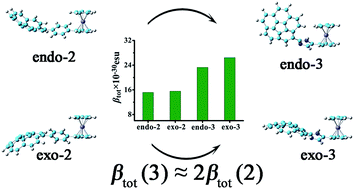The effect of heterocyclic π bridges on second order nonlinear optical properties of compounds formed between ferrocenyl and corannulenyl†
Abstract
Compounds containing a donor (D) connected to an acceptor (A) via a heterocyclic π bridge are known as novel materials with excellent nonlinear optical (NLO) properties. Using the ferrocenyl donor and corannulenyl acceptor, we introduce three five-membered azole rings, including imidazole, oxazole, and thiazole compared with phenyl to systematically determine the contribution of the π bridge to the NLO response of the compounds. By calculating the electronic structures, UV-visible absorbance spectra and first hyperpolarizabilities using density functional theory, we found that the stabilities of the endo and exo conformers are almost the same. Two conformers are easy to convert. Furthermore, the maximum absorption wavelengths of heterocyclic compounds show an apparent red-shift compared with the compound with phenyl as π bridge. This trend indicates that the heterocyclic compounds possess the smaller crucial transition energy, which might lead to a larger NLO response. Interestingly, the first hyperpolarizability values of exo conformers are all larger than those of endo conformers because of the larger degrees of charge transfer transition of the exo conformers compared to those of the corresponding endo conformers. Our research provides important evidence for using five-membered heterocycles as π bridges in enhancing the NLO properties of D–π–A type compounds. Therefore, controlling the kinds of π bridges is an important method in the design of new appealing NLO compounds.


 Please wait while we load your content...
Please wait while we load your content...